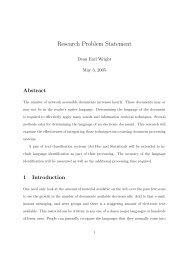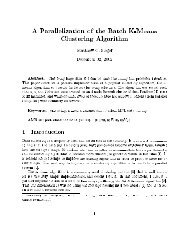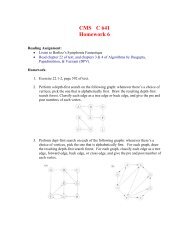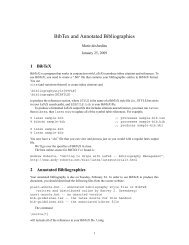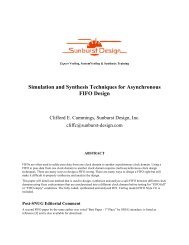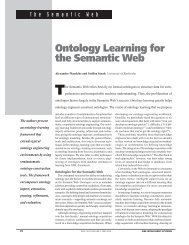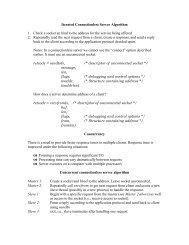Load-Balancing Clusters in Wireless Sensor Networks - ResearchGate
Load-Balancing Clusters in Wireless Sensor Networks - ResearchGate
Load-Balancing Clusters in Wireless Sensor Networks - ResearchGate
Create successful ePaper yourself
Turn your PDF publications into a flip-book with our unique Google optimized e-Paper software.
S j ∈ RSet Gi ⇔[( R Gi > d Sj->Gi ) Λ (R Sj,max > d Sj-->Gi )]Where, R Gi is the range of gateway G i , R Sj,max is themaximum range of sensor S j and d Sj->Gi is the distancebetween sensor S j and Gateway G i . A f<strong>in</strong>al set (FSet) isconstructed based on the m<strong>in</strong>imum communication costbetween sensors and gateways [8]. For the purpose ofrecovery each gateway constructs another set conta<strong>in</strong><strong>in</strong>gnodes that do not belong to the cluster of the gateway butare <strong>in</strong>cluded <strong>in</strong> its RSet. This set is called a Backup set(BSet). Each node only belongs to a s<strong>in</strong>gle FSet but can bepart of many BSets. The def<strong>in</strong>ition of BSet is def<strong>in</strong>ed as:S j ∈ BSet Gi ⇔[( S j ∈ RSet Gi ) Λ (S j ∉ FSet Gi )]When a sensor has to be recovered all the gateways checktheir own BSets for the sensor. The sensor is recovered if itis present <strong>in</strong> the BSet of the gateway. If a sensor is present<strong>in</strong> multiple BSets, it is accommodated by the gateway,which has the m<strong>in</strong>imum communication cost with the sensorother then one failed. Once the sensor is associated with thebackup gateway, it is removed from the BSet of the backupgateway as well as the RSet of the faulty gateway.Due to previous schedule the receivers of the sensor areturned dur<strong>in</strong>g the route update slot to receive the new updatefrom the gateway. Therefore, the backup gateway <strong>in</strong>formsthe sensor about the new association <strong>in</strong> the same slot. NewTDMA schedules are given to the sensor accord<strong>in</strong>g to thecard<strong>in</strong>ality of the new gateway and the sensor becomes apart of the backup cluster.5. Experimental ValidationThe effectiveness of our recovery approach is validatedthrough simulation. This section describes simulationenvironment, fault <strong>in</strong>jection technique and validation of theprotocol.5.1 Environmental SetupExperiments are performed on simulations with 1000sensors and 3 gateways uniformly distributed <strong>in</strong> a 10 × 10square kilometer area. Each sensor is assumed to have an<strong>in</strong>itial energy of 5 joules. A node is considered nonfunctionalif its energy level reaches 0 joules. The maximumrange of the sensors is set to 0.5 times the maximumdistance between two nodes <strong>in</strong> the system. Initial range ofthe gateways is considered enough to cover the whole area.It is assumed that the channel is collision free and packetsare not dropped <strong>in</strong> the medium. <strong>Sensor</strong>s are given IDs <strong>in</strong>random fashion. <strong>Sensor</strong>s are <strong>in</strong>formed about the first TDMAschedules by their respective gateways. Schedule for first<strong>in</strong>ter-gateway communication is decided dur<strong>in</strong>gbootstrapp<strong>in</strong>g. Nodes switch on their transmitter if neededand receiver circuitry only dur<strong>in</strong>g their allocated slots.Fault <strong>in</strong>jection is used to test the robustness andbehavior of the sensor network. Fault <strong>in</strong>jection allowsstudy<strong>in</strong>g the effectiveness fault detection and recoverycapabilities of our system. We use a simulation-based fault<strong>in</strong>jection methodology to <strong>in</strong>ject communication faults <strong>in</strong> thegateways. We created a fault library of possible l<strong>in</strong>k, rangeand complete failures. We then created a timely orderedfailure list us<strong>in</strong>g Poisson distribution for occurrence offaults. Faults are picked from the library based on a Uniformdistribution for the type of failure and Normal distributionfor the location of the fault.We implement a fault-<strong>in</strong>jector module to trigger thefaults as events. The fault-<strong>in</strong>jector keeps a check on thesystem time and compares it with the timestamp of the nextentry <strong>in</strong> the failure list. Whenever the system time equals afault event time, the fault-<strong>in</strong>jector selects the fault from thelibrary, reads the fault dest<strong>in</strong>ation (gateway id) and <strong>in</strong>sertsthe fault <strong>in</strong> the event queue of the gateway. When a gatewayencounters the fault <strong>in</strong> the event queue, it simulates thefault. The consequences of a fault experienced by thesystem are based on its type.G1RouteRFDataDataStatus:G2RouteDataDataCF:Fault InjectorG3DataStatusRouteDataRF-G1 CF-G2 LF-G3 LF-G1 RF-G3 RF-G3 …Fig 5. Design of the fault <strong>in</strong>jection environmentFig 5 describes the design of the fault-<strong>in</strong>jectionenvironment. It shows a l<strong>in</strong>k fault be<strong>in</strong>g <strong>in</strong>jected by thefault-<strong>in</strong>jector <strong>in</strong> gateway G3. Previously, gateway G2 stopsall operation due to complete failure. Also, gateway G1 issuffer<strong>in</strong>g from a range fault. In order to measure theperformance of our approach we calculate the coverage ofthe algorithm. Coverage is the ability of the system to detectand recover from the occurrence of a fault dur<strong>in</strong>g normalsystem’s operation [17].Coverage = Probability [system recovers/fault occurs]We have <strong>in</strong>jected 1000 faults <strong>in</strong> order to measure thecoverage of our algorithm. S<strong>in</strong>ce, complete failures are lesscommon compared to other faults, we have <strong>in</strong>serted themwith lower frequency than range and l<strong>in</strong>k failures. AllLF:5
complete failures are detected <strong>in</strong>stantaneously dur<strong>in</strong>g thestatus period. We <strong>in</strong>jected faults to decrease the range ofgateway G1 by 2% every 15 m<strong>in</strong> of operation. On alloccasion our detection mechanism detects the faults andidentifies the sensors that have gone out of range from thegateways. <strong>Sensor</strong>s are successfully recovered to othergateways till the range of G1 drops below a threshold andonly the sensors very close to G1 are left <strong>in</strong> the cluster.After every subsequent range fault <strong>in</strong> G1 coverage decreasesbecause the algorithm fails to f<strong>in</strong>d any gateway toaccommodate the sensors.L<strong>in</strong>k failures are <strong>in</strong>jected <strong>in</strong> gateway G3 to study theimpact on number of status messages <strong>in</strong> the system. Due tol<strong>in</strong>k failures status messages are not received by othergateways and forward<strong>in</strong>g scheme is activated. Forward<strong>in</strong>g<strong>in</strong>creases the number of status message by (N-2) 2 , where Nis the number of gateways <strong>in</strong> the system. The period ofstatus updates is controlled by MILD algorithm until we<strong>in</strong>ject a burst of faults mak<strong>in</strong>g the recovery more frequent.The coverage of l<strong>in</strong>k failure has been observed to be 100%throughout the simulation until all the <strong>in</strong>com<strong>in</strong>g/outgo<strong>in</strong>gl<strong>in</strong>ks from a gateway fails. After all l<strong>in</strong>k fails, any fault onG3 are detected as a complete failure by other gateways.Recovery of sensors <strong>in</strong> the cluster of G3 is only done on thefirst complete failure.The results of the fault <strong>in</strong>jection experiments clearlydemonstrate that the system is resilient to communicationfaults and recovers efficiently without re-configurations ormanual repairs.6. Conclusions and future work:High-energy gateway node acts as a centralized manager tohandle the sensors and serves as a hop to relay data fromsensors to a distant command node. In this paper we have<strong>in</strong>troduced a two phase; detect and recover fault-toleranceapproach to recover sensors from the failed gatewayswithout shutt<strong>in</strong>g down or re-cluster<strong>in</strong>g the system.Gateways can suffer from complete, l<strong>in</strong>k or range failurescaused due to software or hardware faults. Our approachenables fault-tolerance <strong>in</strong> the system by perform<strong>in</strong>g periodicchecks on the status of the gateways. <strong>Sensor</strong>s managed by afaulty gateway are recovered by re-associat<strong>in</strong>g them to otherclusters based on backup <strong>in</strong>formation created dur<strong>in</strong>g thetime of cluster<strong>in</strong>g.Our future plan <strong>in</strong>cludes extend<strong>in</strong>g the cluster<strong>in</strong>g modelto allow gateway mobility. Also, we plan to <strong>in</strong>tegratebootstrapp<strong>in</strong>g and energy-aware rout<strong>in</strong>g to our approach.References[1] R. Burne, et. al, "A Self-Organiz<strong>in</strong>g, Cooperative UGSNetwork for Target Track<strong>in</strong>g," Proc. of SPIE Conference onUnattended Ground <strong>Sensor</strong> Tech. and Applications II, Orlando,April 2000.[2] "Data sheet for the Acoustic Ballistic Module", SenTech Inc.,http://www.sentech-acoustic.com/[3] W. He<strong>in</strong>zelman, et. al, "Energy-Scalable Algorithms andProtocols for <strong>Wireless</strong> Microsensor <strong>Networks</strong>," Proc.International Conference on Acoustics, Speech and SignalProcess<strong>in</strong>g (ICASSP '00), June 2000.[4] B. Chen, et al., “Span: An Energy-Efficient Coord<strong>in</strong>ationAlgorithm for Topology Ma<strong>in</strong>tenance <strong>in</strong> Ad Hoc <strong>Wireless</strong><strong>Networks</strong>”, Proc. of MobiCom 2001, Rome, Italy, July 2001.[5] S. S<strong>in</strong>gh, M. Woo and C. S. Raghavendra, "Power-AwareRout<strong>in</strong>g <strong>in</strong> Mobile Ad Hoc <strong>Networks</strong>", Proc. of ACMMOBICOM'98, Dallas, Texas, October 1998[6] D. Estr<strong>in</strong>, R. Gov<strong>in</strong>dan, J. Heidemann, and S. Kumar. Scalablecoord<strong>in</strong>ation <strong>in</strong> sensor networks. Proc. of ACM/IEEEMobiCom 1999, Seattle, Wash<strong>in</strong>gton, August 1999.[7] K. Arisha, M. Youssef, M. Younis, “Energy-Aware TDMA-Based MAC for <strong>Sensor</strong> <strong>Networks</strong>,” IEEE Workshop onIntegrated Management of Power Aware Communications,Comput<strong>in</strong>g and Network<strong>in</strong>g (IMPACCT 2002), May 2002.[8] G. Gupta, M. Younis, “<strong>Load</strong>-Balanced Cluster<strong>in</strong>g <strong>in</strong> <strong>Wireless</strong><strong>Sensor</strong> <strong>Networks</strong>”, Submitted to the IEEE Internationalconference on communications (ICC 2003), Anchorage,Alaska, May 2003,[9] J.M. Kahn, R.H. Katz, K.S.J. Pister, Next century challenges:Mobile network<strong>in</strong>g for 'smart dust', Proc. MOBICOM, Seattle,1999[10] Burnste<strong>in</strong>, A., Bult, K., Chang, D, Chang, F. et al. "<strong>Wireless</strong>Integrated Microsensors"; Proceed<strong>in</strong>gs <strong>Sensor</strong>s EXPO 1996,Anaheim, CA., 1996[11] J. Rabaey, J. Ammer, J.L. da Silva, D. Patel, "PicoRadio: Adhocwireless network<strong>in</strong>g of ubiquitous low-energysensor/monitor nodes," IEEE Computer Society Workshop onVLSI 2000, Orlando, FL, pp. 9--12, April 2000.[12] A. Cerpa and D. Estr<strong>in</strong>, “ASCENT: Adaptive Self-Configur<strong>in</strong>g <strong>Sensor</strong> <strong>Networks</strong> Topologies,” Proc. INFOCOM2002, New York, June 2002[13] W. Rab<strong>in</strong>er He<strong>in</strong>zelman, A. Chandrakasan, and H.Balakrishnan, “Energy-Efficient Communication Protocolsfor <strong>Wireless</strong> Microsensor <strong>Networks</strong>,” Hawaii InternationalConference on System Sciences (HICSS '00), January 2000.[14] D.J Baker and A. Ephremides, "A Distributed algorithm forOrganiz<strong>in</strong>g Mobile Radio Telecommunication <strong>Networks</strong>", <strong>in</strong>the Proceed<strong>in</strong>gs of the 2 nd International Conference <strong>in</strong>Distributed Computer Systems, April 1981.[15] M. Gerla and J.T.C Tsai, “Multicluster, mobile, multimediaradio network,” ACM/Baltzer Journal of <strong>Wireless</strong> networks,Vol. 1, No. 3, pp. 255-265, 1995.[16] A.K. Parekh, "Select<strong>in</strong>g Routers <strong>in</strong> Ad-Hoc <strong>Wireless</strong><strong>Networks</strong>", Proceed<strong>in</strong>gs of the SBT/IEEE InternationalTelecommunications Symposium, August 1994[17] J. B. Dugan and K. S. Trivedi, "Coverage Model<strong>in</strong>g forDependability Analysis of Fault-Tolerant Systems", IEEETransactions on Computers, 38 (6), pp.775-87, June 1989[18] S. Han, K. G. Sh<strong>in</strong>, and H. A. Rosenberg, "DOCTOR: AnIntegrated Software Fault Injection Environment forDistributed Real-time Systems," Proceed<strong>in</strong>gs of InternationalComputer Performance and Dependability Symposium,Erlangen, Germany, pp. 204-213, April 1995.[19] M.C. Hsueh, T.K Tsai, R.K Iyer, “Fault Injection Techniquesand Tools”, Computer, April 1997, pp.75-82[20] D. Pradhan, Fault-tolerant computer system design. PrenticeHall Publisher, Englewood Cliffs, New Jersey, USA, 1996.6








